#Minoans
Explore tagged Tumblr posts
Text



Minoan frescoes. The 1600s BC was a great time for fashion.
#art#art history#ancient history#history#ancient greece#greece#frescoes#fresco painting#minoan#minoans#minoan civilization#bronze age#fashion#fashion history#history of fashion#ancient civilizations
2K notes
·
View notes
Text

Greek Farmer Stumbles Onto 3,400-Year-Old Tomb Hidden Below His Olive Grove
The Crete local was trying to park his vehicle when he accidentally unearthed the ancient Minoan grave
Sometime between 1400 and 1200 B.C., two Minoan men were laid to rest in an underground enclosure carved out of the soft limestone native to southeast Crete. Both were entombed within larnakes—intricately embossed clay coffins popular in Bronze Age Minoan society—and surrounded by colorful funerary vases that hinted at their owners’ high status. Eventually, the burial site was sealed with stone masonry and forgotten, leaving the deceased undisturbed for roughly 3,400 years.
Earlier this summer, a local farmer accidentally brought the pair’s millennia-long rest to an abrupt end, George Dvorsky reports for Gizmodo. The farmer was attempting to park his vehicle beneath a shaded olive grove on his property when the ground gave way, forcing him to find a new parking spot. As he started to drive off, the unidentified local noticed a four-foot-wide hole that had emerged in the patch of land he’d just vacated. Perched on the edge of the gaping space, the man realized he’d unintentionally unearthed “a wonderful thing.”
According to a statement, archaeologists from the local heritage ministry, Lassithi Ephorate of Antiquities, launched excavations below the farmer’s olive grove at Rousses, a small village just northeast of Kentri, Ierapetra, in southeast Crete. They identified the Minoan tomb, nearly perfectly preserved despite its advanced age, in a pit measuring roughly four feet across and eight feet deep. The space’s interior was divided into three carved niches accessible by a vertical trench.
In the northernmost niche, archaeologists found a coffin and an array of vessels scattered across the ground. The southernmost niche yielded a second sealed coffin, as well as 14 ritual Greek jars called amphorae and a bowl.
Forbes’ Kristina Kilgrove writes that the high quality of the pottery left in the tomb indicates the individuals buried were relatively affluent. She notes, however, that other burial sites dating to the same Late Minoan period feature more elaborate beehive-style tombs.
“These [men] could be wealthy,” Kilgrove states, “but not the wealthiest.”
Unlike many ancient tombs, the Kentri grave was never discovered by thieves, Argyris Pantazis, deputy mayor of local communities, agrarian and tourism of Ierapetra, tells local news outlet Cretapost. In fact, the site likely would have remained sealed in perpetuity if not for the chance intervention of a broken irrigation pipe, which watered down the soil surrounding the farmer’s olive grove and led to his unexpected parking debacle.


“We are particularly pleased with this great archaeological discovery, as it is expected to further enhance our culture and history,” Pantazis added in his interview with Cretapost. “Indeed, this is also a response to all those who doubt that there were Minoans in Ierapetra.”
According to Archaeology News Network, most Minoan settlements found on Crete are located in the lowlands and plains rather than the mountainous regions of Ierapetra. Still, a 2012 excavation in Anatoli, Ierapetra, revealed a Minoan mansion dating to between 1600 and 1400 B.C., roughly the same time period as the Kentri tomb.
This latest find offers further proof of the ancient civilization’s presence—as Mark Cartwright notes for Ancient History Encyclopedia, the Minoans are most renowned for their labyrinthine palace complexes, which likely inspired the classic Greek myth of Theseus and the Minotaur. According to legend, Queen Pasiphae of Crete gave birth to the Minotaur, a fierce half-man, half-bull hybrid, after falling for a bull sent to Earth by the Greek god Zeus. The Minotaur, doomed to an eternity spent wandering the halls of an underground labyrinth and killing anyone it encountered, was eventually defeated by the demigod Theseus, who relied on an enchanted ball of thread provided by the king’s daughter, Ariadne, to escape the maze.
Much of the Minoans’ history remains unclear, but Forbes’ Kilgrove reports that natural disasters, including the eruption of the Thera volcano, an earthquake and a tsunami, contributed to the group’s downfall, enabling enemies such as the Mycenaeans to easily invade. Analysis of the excavated Kentri tomb may offer further insights on the Minoan-Mycenaean rivalry, as well as the Cretan civilization’s eventual demise.
By Meilan Solly.
(Discovered in Summer 2018)

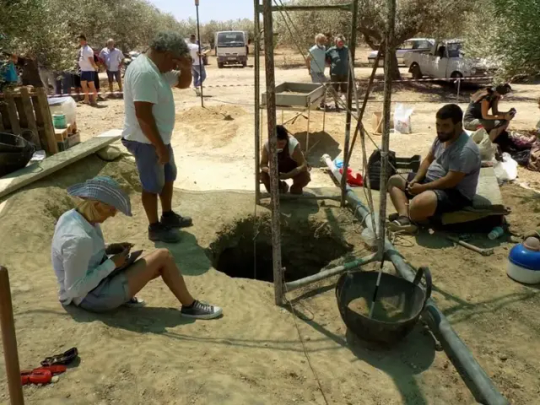
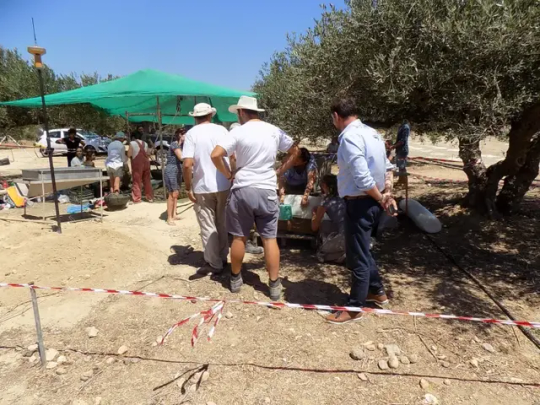

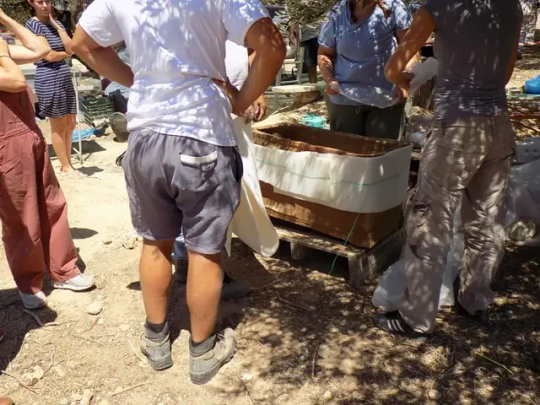

#Greek Farmer Stumbles Onto 3400-Year-Old Tomb Hidden Below His Olive Grove#Crete#Minoans#ancient tomb#ancient grave#grave goods#ancient artifacts#archeology#history#history news#ancient history#ancient culture#ancient civilizations#ancient greece#greek history#greek art#ancient art
214 notes
·
View notes
Text

go athenian boy go
#theseus#greek mythology#tagamemnon#art#drawing#artists on tumblr#digital art#mythology#athens#minotaur#theseus and the minotaur#asterion#minoan civilization#minoans#crete
189 notes
·
View notes
Text

Boar tusk helmet, Minoan, 1450-1400 BC
from The Heraklion Archaeological Museum, Crete
450 notes
·
View notes
Text
Hey babe are you Linear A because I have no idea what the fuck you are saying
#don’t mind me just thinking about ancient languages#linear a#minoans#ancient greece#ancient history#tagamemnon
32 notes
·
View notes
Text
Minoan Jewelry

Minoan jewelry is a stunning example of the intricate craftsmanship and advanced artistry of the Minoan civilization (3000–1450 BC), one of the earliest advanced cultures in Europe, flourishing on the island of Crete, Greece. 🇬🇷
The jewelry on display at the Archaeological Museum of Heraklion, located in Crete, offers a glimpse into the aesthetic and cultural significance of adornment in Minoan society.
The Minoans, known for their advanced metallurgy, created exquisite gold, silver, and bronze jewelry, often adorned with precious gemstones like amber, lapis lazuli, and coral.
The designs were not only beautiful but also held symbolic meaning, often related to gods, nature, and the afterlife.
Among the most remarkable pieces are the gold necklaces, earrings, bracelets, and finger rings, many of which are finely detailed with motifs such as animals, sea creatures, and geometric patterns.
The use of faience (a type of glazed ceramic) is also prominent in Minoan jewelry, adding color and vibrancy to pieces.
These artifacts provide insight into the social and religious practices of the Minoans, as jewelry was often used as a sign of wealth, social status, and divine favor.
The Archaeological Museum of Heraklion houses some of the most significant Minoan jewelry pieces, offering visitors a glimpse into the luxury and refinement of this ancient civilization.
The museum’s collection helps to contextualize these objects within the broader history of Minoan art, rituals and daily life, allowing us to appreciate the craftsmanship that has influenced jewelry design for millennia.
#Minoan#minoan civilization#jewelries#craftsmanship#artistry#Crete#Greece#ancient greece#ancient civilizations#Archaeological Museum of Heraklion#metallurgy#faience#artifacts#Minoans#jewelry design#symbolic meaning#aesthetic#culture#history#cultural significance
26 notes
·
View notes
Text
Time Travel Question 55: Medievalish and Earlier
If you could travel through time, but only to see something for Research or for Fun, not to change anything, what would you pick? Yes, you may have a Babel Fish in your ear to translate.
These Questions are the result of suggestions a the previous iteration. This category may include suggestions made too late to fall into the correct earlier time grouping. In some cases a culture lasted a really long time and I grouped them by whether it was likely the later or earlier grouping made the most sense with the information I had.
Please add new suggestions below if you have them for future consideration. All cultures and time periods welcome.
#Time Travel#Middle Ages#Basilica of Saint Francis of Assisi#Art History#Italian History#Cimabue#Giotto#Simone Martini#Pietro Lorenzetti#Pietro Cavallini#lithophones#History of Music#Homins#Prehistory#Minoans#mythology#Minoan mythology#Ancient Greece#Ancient Rome#Roman Religion#Ötzi#Ötzi the Ice Man#Neanderthal#Neanderthals#Fashion History#Folklore#History of Food
85 notes
·
View notes
Note
Hey there, since you're an archeologist I tought you were the best person I could ask! Do you know something about minoic/mycenean/doric clothes? Like the different kinds that exist and what they're used for or by whom, what kind of fabric are used, what colors, etc,,,
I wanted to design some mythical characters, but I cannot find a reliable source or something detailed about them, so even if you could link me to some page, it would great! (Even if you don't it's no problem, I'm just trying haha)
Thanks ^^
Oh that is a very interesting question and rather wide so I will try to keep it compressed enough so it will not be boring or tiring! Of course the periods are connected to each other and at some point we sure are to expect the styles to co-intricate with each other (for example at several occasions Mycenaeans have very similar iconography as the Minoans -see for example ceremonial images - but as years pass they develop their own style and we see more commonly images with women and men have covered torsos as opposing to the almost always bare chests of minoan men and women.
Now "doric clothes" is a very wide category. As I said Doric Greek tribes descended from the north at around 1100 BC and they stayed ever since in history. Places like north Greece like Macedonia did speak in a Doric Greek dialect. So did the Spartans in the south who are some of the most famous examples of Doric Greek so their clothing depends on the era we talk about.
Of course when it comes to the Minoans (c.a. 3100 BC-1450 BC) we know little on society and such but we have a very rich set of depictions and decorations or statuettes that depict clothing. Men and women in frescoes are generally depicted in a similar manner with the Egyptian counterparts where women are pointed out with white pigment and men with red pigment (distinction that seems very useful in the infamous bull-leaping images where both men and women are dressed in a similar manner so the color differences are needed to point out the two genders (of course there are some professors who debate that fact but this theory is the most prominient one so far), for example I have seen also the suggestion that tan was preferred for men but not for women but I wouldn't be massively convinced on that idea as much but that is up to you.
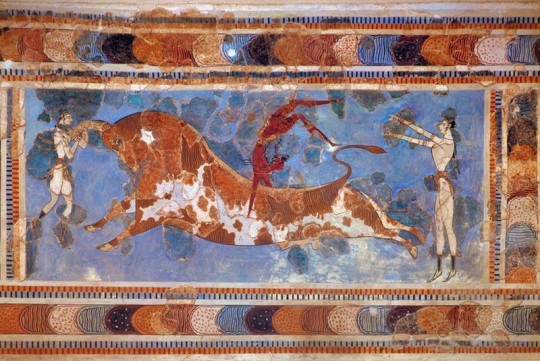
In sports images like this we see both men and women dressed in this loin-cloth material that leaves the torso bare so they will not get caught to the horns of the bull.
Of course one of the most famous ones is the so-called "Snake Goddess" which depicts a very common set of clothing:
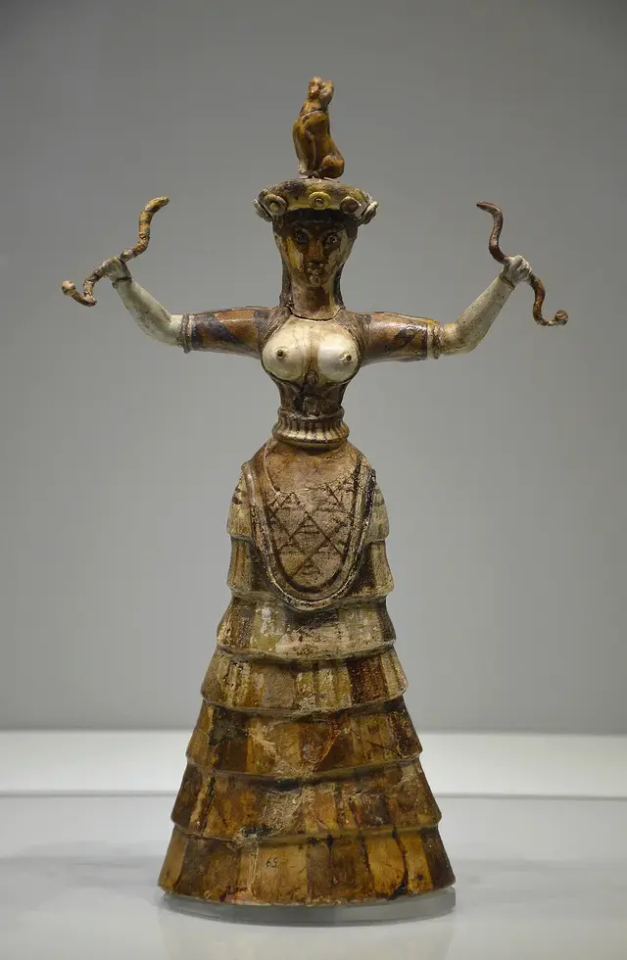
This is what we might call a typical set of clothing for the minoan period from what we know. A classical set is the full skirt with the intricate colorings and patterns, a corset-like garment that puts emphasis on the waist and supports the bodice and a typical short-sleeved top that leaves the breasts open. Although I believe realistically speaking we should expect simpler dresses for the lower clsses of women or that we can assume these types are more official or ceremonial it does seem like the Minoan civilization has less rules for modesty XD. Women had their hair long and arranged in braids or locks (there are even people who estimate that the minoans have some of the earliest depictions of locked hair in history) More often whatnot they arranged their hair with jewelry and from the frescoes we know they had very vibrant colors.
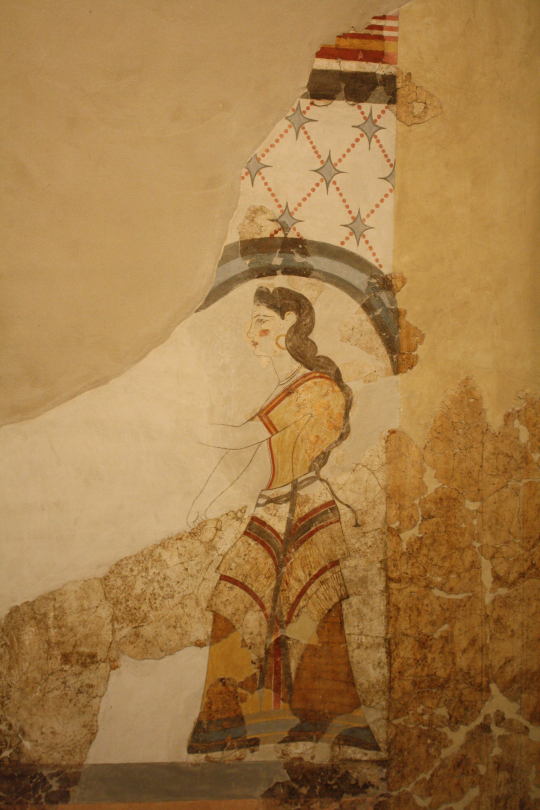
Judging from the coloring patterns and such I would say that woolen materials were used although looming comes in popularity in later years.
Women also wore a variety of accessories in their hair and bodies with beaded necklacess and golden earrings
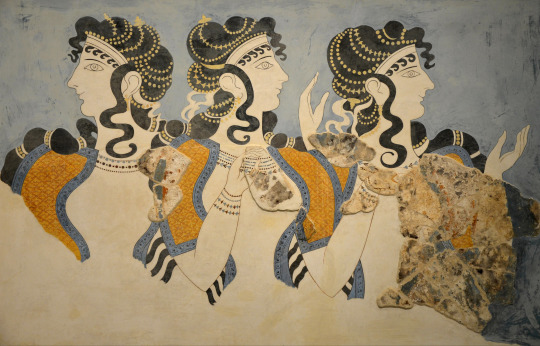
We have actually some really beautiful examples of golden jewelry from that time
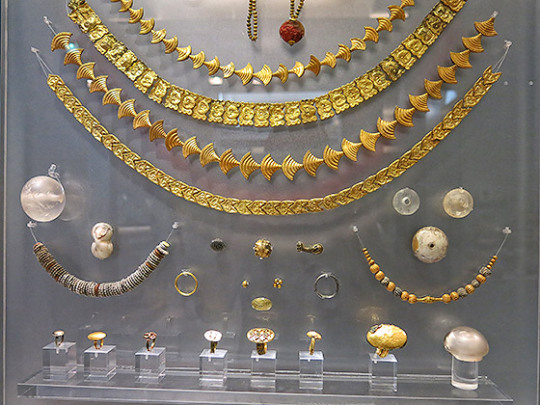
Or the famous "bees" pendant
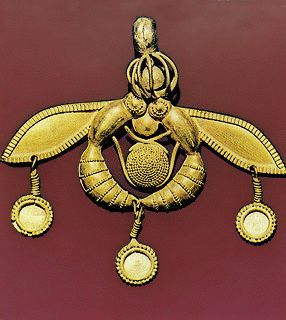
We can also safely assume that women wore makeup from the fresco discovered in Knossos that was named "Parisian girl" because of her red lipstick and jewelry
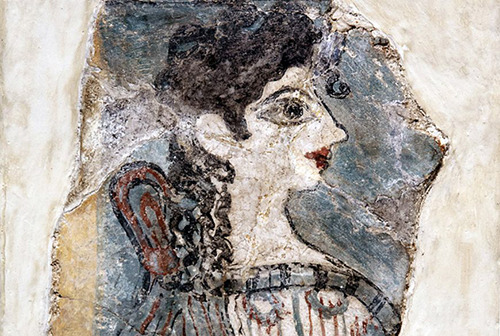
Now men also have very vibrant colors but by n large they are depicted bare-chested wearing usally skirts or loincloths around their waists as they perform their activities
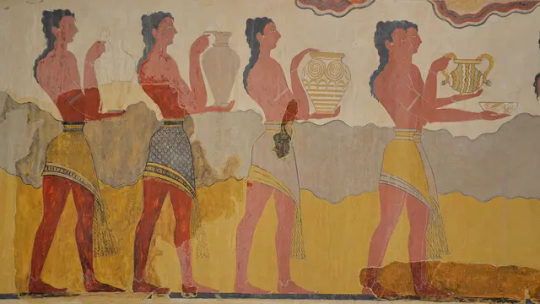
We see intricate geometric patterns in some of their clothes and we see they keep their hair also long and carefully arranged. We also see them most of the time clean-shaven and we do discover blades that we estimate they were used as razors so it seems that shaving played a big part in their culture. For men we do not see so vibrant depictions of jewelry but we do discover impressive sigil rings in their tomb. And of course there is the infamous "Prince with the Lillies"
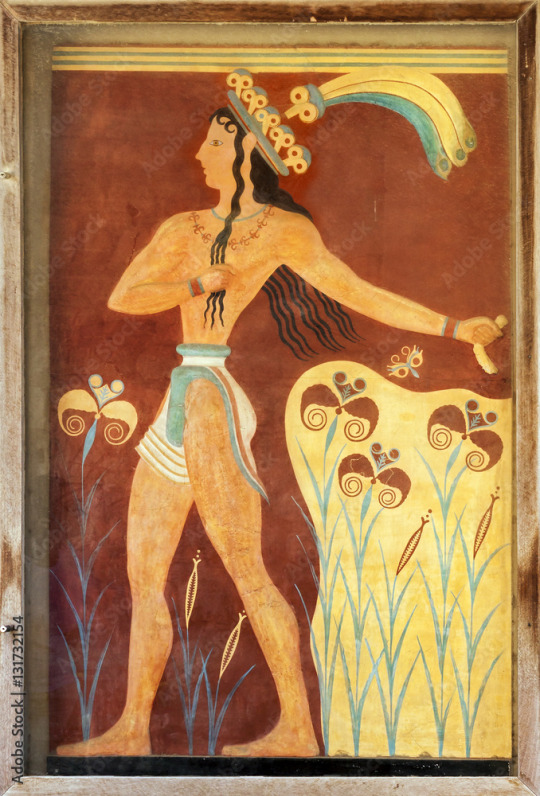
Of course this representation was initially suggested by Arthur Evans and there is little to no guarantee that this is how it really looked like (the hat in particular has been commented by recent professors I interracted with, with a female type of hat) but it still remains a famous depiction to this day. The loin cloth that he is wearing resembles the bull fighters
Now do I believe it is possible they had warmer clothing for winter? Absolutely even if we do not see as cold climates in southern Greece especially at those times I believe one could assume some warmer garment to be worn but unfortunately is hard to tell from iconography only.
The Mycenaeans (c.a. 1700s BC-1100 BC) as I said before do have a very similar iconography to the Minoan times but later on they establish their own style. We do have processions such as the one discovered in the palace of Pylos in whic the procession of women is dressed up in an identical fashion with the minoan counterparts:
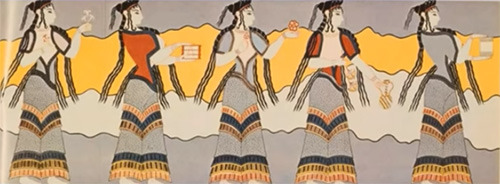
There seems to be the suggestion though that this kind of garments were mostly used by the elite class and/or for ceremonial purposes instead of everyday life. Which seems to be supported by the fact that we usually see heavily decorated women walk in processions. Instead we see more and more women covering their chests with bodices or with the dress itself such as below:
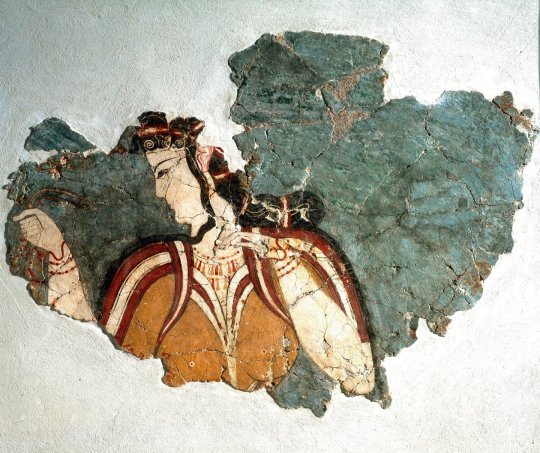
And this is a possible reconstruction:

We also see a variety of hairstyles like the one above with ladies wear their hair either in long locks or brushed like we saw before or gathered up in smaller buns and arrangements like the lady above. Other clothing such as this suggestion from Mycenae show even intriquette shawls or robes such as these:

Other chitons that have longer sleeves seem to be painted upon mycenaean statuettes as well.
With accessories we see also jewelry of gold or beads and on makeup we see examples of these rosettes or circular patterns on faces of women. I really like this project that seems to try and reconstruct Helen based on Mycenaean images:


and the use of the woman head depiction for the makeup. Headbands crowns or impressive plummed hats were also a thing

Men are quite similar and at the beginning they do resemble the minoan style but now there seems to be a turn towards hunting and war scene iconographically

where we see a variety of shields and weapons such as spears or bows also depictions of soldiers with armory:

which of course also has different shapes and materials from possibly leather ones such as these in the vase painting till full on bronze ones like this famous sample:

And of course the infamous boar-tusk helmet, like the one thoroughly described in the Iliad being the helmet upon the head of Odysseus:

In fact Homer seems to be rather accurate on the description of it and it corresponds to the images of the vase painting with men wearing boar tusk helmets adorned with plumes and horns (yeah sweet irony how it was uncommon for Vikings to wear horned helmets and yet media depicts them with them while ancient Greeks did have horned helmets and no one depicted them with them! Hahaha!).
We also see the existence of beards to men so it seems fashion calls for beards in older men and shaven faces for younger ones which remains kinda the norm for the later years to come. Other depictions show men clothed in short nd short-sleeved chiton with or without helmets and often their clothing have vibrant colors:

Boar tusks began being kind of like a status symbol for we find many of them to burials along with weapons so we tend to believe they were signs for warriors.
For material now it seems that Homer was rather accurate depicting his women weaving and looming. The existence of loom weight in our discoveries show the woolen threads being famously used in looming and we even discovered funeral shrouds (like the one Penelope ellegedly wanted to prepare for Laertes) in burials in burial circle B in Mycenae

patterns were often painted or loomed upon the skirts or clothing. Flax was also another material one would expect was used at that time for clothing-making. One can assume fur or other materials from hunted or farmed animals would be used for warmth at colder months especially in cities located inside the mainland.
Thankfully for us the mycenaean greek scripture (Linear B) is deciphered so we do know on products moving from and to the palace (unfortunately the scriptures we have are mainly logistics)
So to do a recap yeah minoan and mycenaean clothing had really vibrant colors and intriquate patterns. By n large Mycenaean Civilization has simpler lines to the clpothing and tend to choose options with less nudity unless we speak on ceremonial or official dresses of the upper class (of course exceptions to the rule should have existed but we do not have as much data on it). On materials we see more wool or flax that is woven in a very skillful fashion as for armory and helmets we do see a variety of shapes and material with prominient things being leather, bronze and boar tusk.
Beautiful jewelry of gold and precious stones were also worn especially in the images of women in procession (most likely for celebrations or ceremonies). We do see depictions of men with beards and often shorter hair (possibly youths that have come of age who are to let their hair grow again, if they follow the same logic as we know of future times to follow)
Hair and hair fashion does seem to change although we discover some remains of it to the later 7th century Kouroi and Kores statues where Kouroi have often long hair depicted n ringles or ropes which again could be the indication of curly, braided or locked hair to indicate the continuation of the long-haired fashion even in later years in antiquity such as the archaic period.


Now as I said before doric greek clothing highly depends on the area, the timeline and the city-state we are talking about so it could be a subject on another ask or a reblog on specific eras and areas (Sparta Macedonia etc) depending also on the era we are talking about we can detect some differences in fashion. Generally we have more scarce information on the period of the Dark Ages (after 1100s till the 7th century BC)
For Minoans and Mycenaeans I could look for more bibliography if you want. You can check these two sites where you can find much of the information I list here:
I hope this helps a bit! I will be open for more answers in more detail! ^^
#katerinaaqu answers#greek mythology#tagamemnon#archeology#mycenaeans#minoans#minoan and mycenaean fashion#ancient greek clothing#ancient greek art#ancient greek armors#ancient greek pottery#ancient greek murals#ancient greek jewelry#history#bronze age greece#ceramic art#wallpaintings#visual art#art history
74 notes
·
View notes
Text


The palaikastro kouros
13 notes
·
View notes
Text

Knossos, Crete
#art#greece#byzantium#ancient greece#history#hellas#ancient history#archaeology#minoans#knossos#crete
15 notes
·
View notes
Text
Minoan Blog + Discord Server!

As some of you may have noticed, I haven't been active on Tumblr (or IG, for that matter) in a long while. That's because my primary focus has been my main blog/website, Minoan Magissa, which you can check out (and potentially follow) here:
Many of you who followed this Tumblr (formerly Greco Witch) did so due to my mostly Hellenic Polytheism content, but I've been particularly drawn to the ancient civilization that greatly influenced the Mycenaean Greeks and beyond. Also, I'm Cretan Greek, so I figured what better way to honor my ancestors and connect with the magic of Crete than to devote an entire blog to it. However, I still consider myself to be both a Minoan AND Hellenic mystic to my core. Anyway, about the Discord server I recently created (Minoan Palace)... If you're interested in discussing/finding out more about Minoan civilization (not just the mystical aspects, but the art, food, way of life, archaeological findings, resources, etc.), then click here to request to join! There's also a discussion section for Hellenic Polytheism and Ancient Greece.
#minoan civilization#minoans#minoan blog#minoan paganism#minoan website#discord server#discord chat#hellenic polytheism#hellenic paganism#minoan pagan#hellenic pagan#hellenic polytheist#ancient civilizations
8 notes
·
View notes
Text

This week's hyper fixation ; Minoan civilization.
The Minoans have been heavy on my mind lately. Maybe also because of the documentaries I've watched....
I love how colorful their frescos are and the fashions of the time 😌
Biggest issue; why is there so little left of them?? Why did they have to be wiped out like that... honestly wish I could go back in time to experience their culture and daily life.
85 notes
·
View notes
Text

🌊🧡Saffron Wave has updated!!🧡🌊
Reblogging helps spread the word and reach new readers!!
✨ First Page ✨ Latest Page ✨ Patreon ✨ ComicFury (1 update behind) ✨
#minoan#webcomics#minoans#webcomics on tumblr#historical comics#magical girls#artists on tumblr#saffron wave#original magical girl#historical fantasy#spiderforest
8 notes
·
View notes
Text

A historically themed pony today.
53 notes
·
View notes
Text
Our society went to ruin when we stopped dressing like the minoans
25 notes
·
View notes
Text
was doing some research (again) on Eileithyia Cave for the Dancing Ground and this book on the site came up in the search results and absolutely Wrecked me

Eileithyia was a childbirth goddess and her shrine is full of votives themed around babies, family, and pregnancy and this one on the cover seems to be of a woman in labor. But like, it looks exactly like a modern water birth?? Even the person behind supporting her? And like the way she's got her arm back to touch them uuuuughghghgh I'm feeling Unwell about this fucking figurine you guys

9 notes
·
View notes